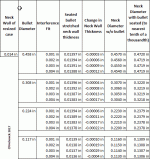I know common wisdom suggests that calipers are all you ever need to measure anything, it takes real practice to get all measurements right with them. Micrometers with 0.0001" resolution scales really make a lot of these things easier for the average person to do. As Redding suggests, I've never seen an inside diameter measurement off calipers get closer than about 0.002". This is not just because of bridging, but even between to pins in a plate of metal I've found most calipers just don't have the ID jaw's flats ground to the exact same zero as the OD jaws and most folks don't commonly have a convenient way to zero them. Moreover, even on OD measurements many folks, faced with a round object OD to measure that has flex in it, like a case mouth, don't realize how little pressure it takes to distort that object nor how little off-axis the jaws need to be to deflect the caliper jaws themselves. These are reasons 0.001" precision even for OD measurements are commonly given.
Expanding small hole gauges, used with a micrometer by adjusting it down in tenths of a thousandth until light drag is felt pulling the gauge through the measuring surfaces will usually get you within two or three tenths of a thousandth of true diameter. It does take practice to get the feel for it, though.
Pin gauges are an acid test for diameter, but the standard economical foreign-made sets ($50 on Amazon) are in 0.0010" increments and are class ZZ with either +0.0002" or -0.0002" tolerance (you get to choose), so you can't get between-thousandths numbers with them. You can measure tenths by ordering special sets of 25 pin gauges (center value gauge and plus and minus 12 gauges in 0.0001" increments with class X tolerance of 0.00004"). At
today's prices (see last page) it is almost $200 n that size range.
The best way for most handloaders to approach the problem is with thimble micrometers. You and measure the resized neck OD before (go all the way around and average the results as most necks are very slightly oval) and again after seating a bullet in it. The difference is very close to the actual interference fit between the neck and bullet, less a tiny bit for stretching thinning out the neck (see table below; it's not much). Once you know what it's going to be with a bullet you only need the resized diameters to judge changes in springback.
Going through all this bother, you can discern why custom rifle builders make special narrow chamber necks. Many cartridge specs allow a range of about 0.004" in neck wall thickness. Chambers are made to accommodate the thickest brass made and still have a little extra room for expansion to release the bullet. Your die maker has to allow it may be at the minimum, so he has the die over-resize. A custom chamber can be made just for average neck wall thickness or for outside turned neck walls and only allow half a thousandth for bullet release expansion. You just have to be able to double check that your necks are right for it and be able to turn down any that are too big. But it cuts way, way down on how much necks expand on firing and way down on how much you need to size them down to hold a bullet again.
I don't know how the use of the term 'neck tension' got started. What is under tension in a neck when a bullet is seated is the circumference of it, which experiences hoop tensile stress and strain. The bullet experiences compression stress from the spring of the neck circumference around it. Combined with the friction between the inside neck and bullet surfaces due to that compression stress, which would be measured in psi, you get a resulting bullet pull. You can control this by the amount of interference fit between the resized neck and the bullet, but you can't control it to an exact psi unless you keep necks annealed to a constant hardness and keep the insides of the neck consistently surfaced so the friction doesn't vary. Not easy tasks for the handloader and probably more trouble than it's worth for most.


